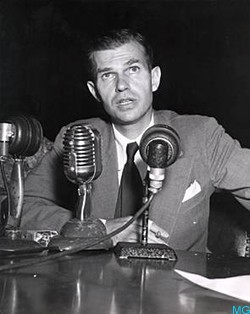01.18
This week (January 18-24) in crime history – Washington DC mayor Marion Barry was arrested on drug charges (January 18, 1990); Nazi Klaus Barbie, the Butcher of Lyons was arrested in Bolivia (January 19, 1983); Notorious World War II traitor, Tokyo Rose was pardoned by President Ford (January 19, 1977); NFL Pro football player and convicted murderer Rae Carruth was born (January 20, 1974); Carl Switzer, who played Alfalfa in the “Our Gang” series was killed (January 21, 1959); Alger Hiss was convicted of perjury (January 21, 1950); Murder of Garrison, Texas police officer was filmed on dash board camera (January 23, 1991); Confession of Emmit Till’s murderers was published in Look magazine (January 24, 1956)
Highlighted Crime Story of the Week –

On January 21, 1950, former State Department official Alger Hiss was convicted of perjury. He was convicted of having perjured himself in regards to testimony about his alleged involvement in a Soviet spy ring before and during World War II. Hiss served nearly four years in jail, but steadfastly protested his innocence during and after his incarceration.
The case against Hiss began in 1948, when Whittaker Chambers, an admitted ex-communist and an editor with Time magazine, testified before the House Un-American Activities Committee and charged that Hiss was a communist in the 1930s and 1940s. Chambers also declared that Hiss, during his work in the Department of State during the 1930s, had passed him top secret reports.
Hiss appeared before HUAC and vehemently denied the charges, stating that he did not even know Chambers. Later, after confronting Chambers face to face, Hiss admitted that he knew him, but that Chambers had been using another name at the time. In short order, Chambers produced the famous “Pumpkin Papers,” copies of the documents he said Hiss passed him during the 1930s. They were dubbed the “Pumpkin Papers” because Chambers kept them hidden in a pumpkin in his pumpkin patch.
Charges and countercharges about the spy accusations soon filled the air. Defenders of Hiss, such as Secretary of State Dean Acheson, declared that President Truman’s opponents were making a sacrificial lamb out of Hiss. Truman himself declared that HUAC was using “red herrings” to defame Hiss. Critics fired back that Truman and Acheson were “coddling” communists, and that Hiss was only the tip of the iceberg. They claimed that communists had penetrated the highest levels of the American government.
Eventually, Hiss was brought to trial. Because the statute of limitations had run out, he was not tried for treason. Instead, he was charged with two counts of perjury, for lying about passing government documents to Chambers and for denying that he had seen Chambers since 1937. In 1949, the first trial for perjury ended in a deadlocked jury. The second trial ended in January 1950 with a guilty verdict on both counts. The case would also propel congressmen and future President Richard Nixon into the spotlight for his dogged persecution of the case.
The battle over the Hiss case continued long after the guilty verdict was handed down. Though many believed that Hiss was a much-maligned official who became a victim of the anticommunist hysteria of the late-1940s, others felt strongly that he was a lying communist agent. Until his death at the age of 92 on November 15, 1996, Hiss never deviated from his claim of innocence.
Check back every Monday for a new installment of “This Week in Crime History.”
Michael Thomas Barry is a columnist for www.crimemagazine.com and is the author of seven nonfiction books that includes the soon to be released In the Company of Evil Thirty Years of California Crime, 1950-1980 and the award winning Murder and Mayhem 52 Crimes that Shocked Early California, 1849-1949.











